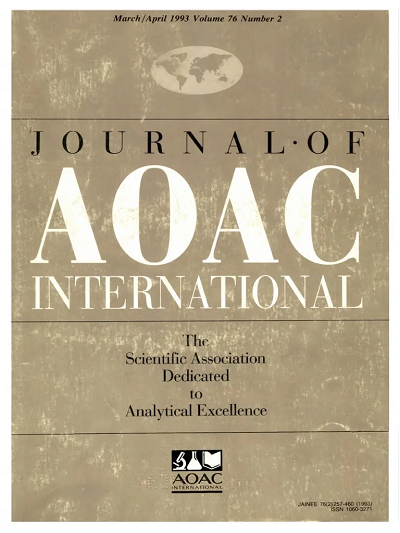通过测量配料粉末原料的水活性进行稳定性研究
IF 1.7
4区 农林科学
Q3 CHEMISTRY, ANALYTICAL
引用次数: 0
摘要
原材料的背景保持时间非常重要,因为它能让我们了解在生产过程开始前,原材料在理想的储存条件下可以保持多长时间而不会影响其质量属性。水活度的定量可作为试样的微生物、物理化学和感官稳定性的指标,因为低水活度可阻止自水解和微生物生长。本研究的主要目的是通过测量水活度来检测粉末状原材料在最长 8 天的保存时间内的稳定性。因此,微生物、物理化学和感官测量同时并行进行,以便通过实验确定加工原料的水活性状态与微生物、物理化学和感官结果之间的关系。结果 根据美国药典(USP)各专著的规定,原材料的最长保存时间为 8 天。在第 0 天、第 3 天和第 8 天,使用露点冷镜法对所有受测原料的水活性进行了测量。在第 0 天和第 8 天,进行了微生物、物理化学和感官评估。结果表明,在这些贮藏条件下,经过加工的原材料在整个贮藏期间的水分活度均低于 0.60。不过,在第 0、3 和 8 天之间,水活性水平存在显著的统计学差异(方差分析 P < 0.05)。尽管不同天数之间存在显著的统计学差异,但在水活度低于 0.60 的情况下,微生物、物理化学和感官特征均符合规范要求。结论 水活度低于 0.60 时,微生物无法生长,感官和理化特性也不会受到影响。结果表明,水活度可用作测试原材料微生物含量和化学稳定性的指标。本文章由计算机程序翻译,如有差异,请以英文原文为准。
Stability Study Through Water Activity Measurements for Dispensed Powdered Raw Materials
Background Holding times for raw materials are relevant, since they enable us to understand the allowable time that a raw material can be kept under ideal storage conditions before the start of the manufacturing process without its quality attributes being affected. The quantification of water activity can be used as an indicator of the microbiological, physicochemical, and organoleptic stability of a specimen, since low water activity retards autohydrolysis and microbiological growth. Objective The main purpose of this investigation was to test the stability of powdered raw materials for a maximum holding time of 8 days through water activity measurements. Thus microbiological, physicochemical, and organoleptic measurements were carried out in parallel and simultaneously in order to experimentally establish a relationship between the status of the water activity of processed raw materials and the microbiological, physicochemical, and organoleptic results. Results The raw materials were stored for a maximum holding time of 8 days, in accordance with USP monographs. For all the raw materials tested, water activity measurements were performed using the dew point chilled-mirror method on days 0, 3, and 8. On days 0 and 8, microbiological, physicochemical, and organoleptic assessments were performed. It was established that under these storage conditions, the processed raw materials exhibited water activity below 0.60 during the entire holding time. However, there were statistically significant differences in water activity levels between days 0, 3, and 8 (ANOVA P < 0.05). Despite observing statistically significant differences between days, the microbiological, physicochemical, and organoleptic features were within specification at those water activity levels, below 0.60. Conclusion Water activity below 0.60 does not allow the growth of microorganisms, and the organoleptic and physicochemical features remain unperturbed. The results indicate that water activity can be used as an indicator of the microbiological load and chemical stability of the raw materials tested.
求助全文
通过发布文献求助,成功后即可免费获取论文全文。
去求助
来源期刊

Journal of AOAC International
医学-分析化学
CiteScore
3.10
自引率
12.50%
发文量
144
审稿时长
2.7 months
期刊介绍:
The Journal of AOAC INTERNATIONAL publishes the latest in basic and applied research in analytical sciences related to foods, drugs, agriculture, the environment, and more. The Journal is the method researchers'' forum for exchanging information and keeping informed of new technology and techniques pertinent to regulatory agencies and regulated industries.
 求助内容:
求助内容: 应助结果提醒方式:
应助结果提醒方式:


